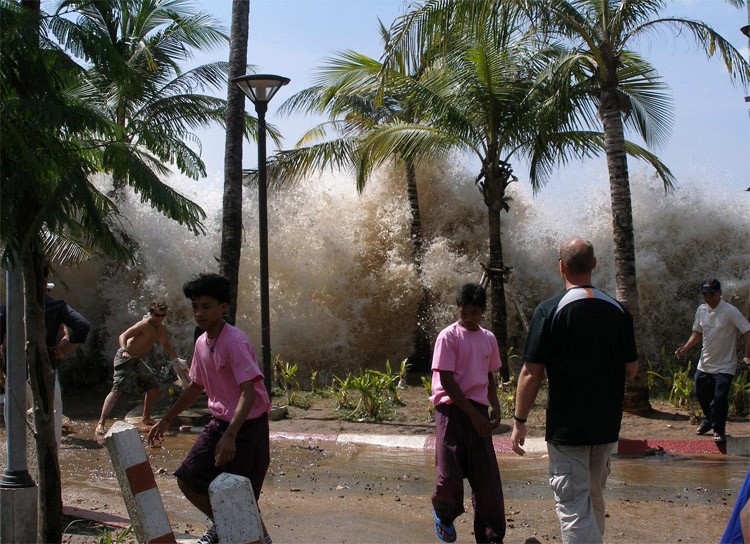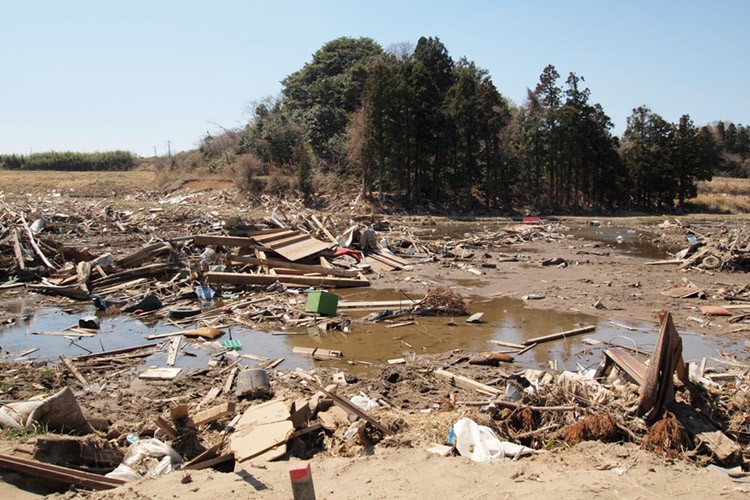This article, brought to you by TRAVELS.EDU.VN, delves into the significant distances tsunamis can travel inland, examining factors influencing their reach and offering crucial safety guidelines. Understanding tsunami inland travel distance is vital for coastal residents and travelers alike, as it allows for better preparedness and mitigation strategies. Let’s explore tsunami inundation zones, evacuation planning, and coastal safety measures.
1. What Factors Determine How Far a Tsunami Travels Inland?
The distance a tsunami travels inland, also known as its inundation distance, is highly variable and depends on several interacting factors:
-
Earthquake Magnitude and Type: The size and type of earthquake generating the tsunami are primary determinants. Larger magnitude earthquakes typically produce larger tsunamis with greater inland reach. A 9.0 magnitude earthquake, such as the one that triggered the 2011 Tohoku tsunami in Japan, can cause significantly more extensive inundation than a 7.5 magnitude event.
-
Coastal Bathymetry and Topography: The underwater topography (bathymetry) near the coast and the land’s elevation (topography) play crucial roles. Shallow, gently sloping coastlines allow tsunamis to travel much farther inland compared to steep, rocky coastlines. For instance, a tsunami may travel several kilometers inland across a flat coastal plain but only a few hundred meters up a steep cliff.
-
Tsunami Wave Height and Period: The height and period (time between wave crests) of the tsunami waves are essential. Higher waves with longer periods carry more energy and can inundate larger areas. The 2004 Indian Ocean tsunami had wave heights exceeding 30 meters in some locations, leading to extensive inland flooding.
-
Tide Level at Time of Impact: The tide level when the tsunami strikes can significantly affect inundation. A high tide will allow the tsunami to reach farther inland, while a low tide may reduce its impact.
-
Coastal Vegetation and Structures: Coastal vegetation, such as mangroves and forests, can help dissipate tsunami energy and reduce inland penetration. Similarly, well-engineered coastal defenses, like seawalls and breakwaters, can protect inland areas. However, poorly designed structures may collapse and exacerbate the damage.
 Coastal Damage from Tsunami | alt: Tsunami's destructive power evident in coastal damage.
Coastal Damage from Tsunami | alt: Tsunami's destructive power evident in coastal damage.
2. How Far Inland Can a Tsunami Realistically Travel?
While there is no fixed limit to how far a tsunami can travel inland, here are some realistic estimates based on historical events and scientific studies:
-
Typical Inundation Distances: In most tsunami events, inundation distances range from a few hundred meters to several kilometers. For example, a moderate tsunami might travel 1-2 kilometers inland on a gently sloping coast.
-
Extreme Cases: Under extreme conditions, such as those seen in the 2004 Indian Ocean tsunami or the 2011 Tohoku tsunami, inundation distances can exceed 10 kilometers (6 miles) or more. The 2011 Tohoku tsunami reached up to 10 km inland in some areas of Japan due to a combination of high wave heights and flat coastal terrain, according to a research report by Tohoku University.
-
Factors Affecting Extreme Distances: Extreme inundation distances typically occur when a very large earthquake generates a massive tsunami that coincides with a high tide and strikes a low-lying coastal area with minimal vegetation or engineered defenses.
3. What are Tsunami Inundation Maps and Why are They Important?
Tsunami inundation maps are crucial tools for coastal communities, providing vital information for emergency planning and mitigation.
-
Definition and Creation: These maps are created using sophisticated computer models that simulate tsunami behavior based on various scenarios, including different earthquake magnitudes, fault locations, and coastal topography. The models consider factors like wave propagation, inundation depth, and flow velocity to predict the extent of flooding.
-
Key Information Provided: Tsunami inundation maps typically show the maximum expected inland extent of flooding, water depths, and areas at high risk. They may also include evacuation routes, safe zones, and locations of critical facilities like hospitals and emergency shelters.
-
Importance for Coastal Communities:
- Emergency Planning: Maps help local authorities develop effective evacuation plans, identify safe assembly points, and determine the resources needed for response efforts.
- Land Use Planning: Maps inform land-use decisions, guiding the placement of new construction and infrastructure away from high-risk areas.
- Public Awareness: Maps educate the public about tsunami hazards, helping residents and visitors understand the risks and take appropriate precautions.
 Tsunami Evacuation Sign | alt: Tsunami evacuation route marker.
Tsunami Evacuation Sign | alt: Tsunami evacuation route marker.
4. How Can Coastal Communities Prepare for Potential Tsunami Inundation?
Effective preparation is critical for minimizing the impact of tsunamis on coastal communities. Here are some key strategies:
- Early Warning Systems: Invest in and maintain reliable tsunami early warning systems that can detect tsunamis and issue timely alerts to coastal populations. These systems typically involve a network of seismographs, sea-level sensors, and communication infrastructure.
- Evacuation Planning: Develop and regularly update detailed evacuation plans that clearly outline evacuation routes, assembly points, and procedures for assisting vulnerable populations. Conduct regular drills to ensure residents are familiar with the plans.
- Coastal Zone Management: Implement coastal zone management policies that restrict development in high-risk areas, promote the preservation of natural coastal defenses like mangroves, and require new construction to meet stringent building codes for tsunami resistance.
- Public Education and Awareness: Conduct ongoing public education campaigns to raise awareness about tsunami hazards, promote understanding of warning signs, and encourage preparedness measures such as preparing emergency kits and developing family communication plans. TRAVELS.EDU.VN can assist in providing educational materials and workshops for your community.
- Infrastructure Improvements: Construct or reinforce critical infrastructure, such as hospitals, schools, and emergency services buildings, to withstand tsunami forces. Consider building elevated platforms or vertical evacuation structures in areas where horizontal evacuation is not feasible.
5. What Should You Do If You Are in a Tsunami Inundation Zone When a Tsunami Strikes?
If you find yourself in a tsunami inundation zone when a tsunami strikes, immediate action is crucial for your survival.
-
Stay Informed: Stay updated by tuning into local news channels and monitoring official alerts.
-
Evacuate Immediately: If you receive a tsunami warning or observe signs of an approaching tsunami (such as a sudden rise or fall in sea level), evacuate immediately to higher ground or inland areas. Do not wait for official instructions if you sense danger.
-
Move Inland and Upward: Move as far inland and as high above sea level as possible. If possible, aim for a location at least 2 miles (3.2 kilometers) inland and 100 feet (30 meters) above sea level.
-
Seek Shelter: If you cannot reach high ground, seek shelter in a strong, multi-story building and move to the highest possible floor.
-
Avoid Coastal Areas: Stay away from beaches, harbors, and other coastal areas. Tsunamis can arrive as a series of waves, with the first wave not necessarily being the largest.
-
Protect Yourself: If caught in a tsunami wave, grab onto a floating object and try to stay above the water. Protect your head and neck from debris.
-
After the Tsunami: After the tsunami, remain in a safe location until authorities declare it is safe to return. Be aware of potential aftershocks and additional tsunami waves.
 Tsunami Warning Sign | alt: A sign indicating a Tsunami Hazard Zone.
Tsunami Warning Sign | alt: A sign indicating a Tsunami Hazard Zone.
6. How Fast Do Tsunamis Travel?
Tsunamis are characterized by their incredible speed, especially in deep ocean waters.
- Speed in Deep Water: In the open ocean, tsunamis can travel at speeds exceeding 500 miles per hour (800 kilometers per hour), comparable to the speed of a jet airplane. The speed is related to the water depth, with deeper water allowing for faster propagation.
- Slowing Down in Shallow Water: As a tsunami approaches the coast and enters shallower water, its speed decreases significantly. However, the wave height increases dramatically. In shallow coastal waters, tsunami speeds may slow to 30-50 miles per hour (50-80 kilometers per hour).
- Implications for Coastal Areas: Despite the reduced speed in shallow water, tsunamis still pose a significant threat to coastal areas due to their immense size and destructive power. The rapid increase in wave height can cause widespread flooding and damage.
7. What Are the Differences Between Local and Distant Tsunamis?
Tsunamis are generally classified into two categories based on their origin and travel time:
- Local Tsunamis: Local tsunamis are generated by earthquakes or other events occurring near the coastline, typically within a few hundred kilometers. They can arrive very quickly, sometimes within minutes of the generating event. Because of the short arrival time, local tsunamis pose a significant challenge for early warning systems and require immediate evacuation based on natural warning signs.
- Distant Tsunamis: Distant tsunamis are generated by events occurring thousands of kilometers away. They can take several hours to reach distant coastlines, providing more time for early warning systems to issue alerts and for communities to evacuate. The Pacific Tsunami Warning Center (PTWC) monitors the Pacific Ocean for distant tsunamis and provides warnings to countries throughout the region.
The key differences lie in the travel time and the available warning time. Local tsunamis require immediate action, while distant tsunamis allow for a more measured response based on official warnings.
8. Can Artificial Structures Protect Against Tsunamis?
Artificial structures, such as seawalls, breakwaters, and coastal barriers, can provide some protection against tsunamis, but their effectiveness depends on several factors:
- Seawalls: Seawalls are designed to protect coastal areas from erosion and storm surge, and they can also provide some protection against small to moderate tsunamis. However, they may be overwhelmed by large tsunamis, and their failure can create additional hazards.
- Breakwaters: Breakwaters are offshore structures designed to reduce wave energy and protect harbors and coastlines. They can be effective in reducing the impact of tsunamis, but their effectiveness depends on their size, location, and design.
- Coastal Barriers: Coastal barriers, such as levees and dikes, can provide protection to low-lying coastal areas. However, they must be well-engineered and maintained to withstand the forces of a tsunami.
- Limitations and Considerations: Artificial structures can provide a false sense of security if they are not properly designed or maintained. In some cases, they may even exacerbate the impact of tsunamis by reflecting wave energy or impeding natural drainage. It is important to consider the potential environmental impacts of artificial structures and to integrate them into a comprehensive coastal zone management plan.
According to research from the American Society of Civil Engineers, the design and placement of these structures must be carefully considered to maximize their effectiveness and minimize potential negative impacts.
9. What Role Does Technology Play in Tsunami Detection and Prediction?
Technology plays a critical role in tsunami detection and prediction, enabling early warning systems and supporting emergency response efforts.
- Seismographs: Seismographs are used to detect earthquakes, which are the primary trigger of tsunamis. By analyzing the magnitude, location, and depth of an earthquake, scientists can estimate the potential for a tsunami.
- Sea-Level Sensors: Sea-level sensors, such as tide gauges and bottom pressure sensors, are used to detect and measure tsunami waves as they propagate across the ocean. Bottom pressure sensors are particularly effective because they can detect tsunamis in deep water, allowing for earlier detection and more accurate predictions.
- Communication Systems: Communication systems, such as satellites, radio, and internet, are used to disseminate tsunami warnings to coastal communities. Timely and effective communication is essential for ensuring that people can evacuate safely.
- Computer Modeling: Sophisticated computer models are used to simulate tsunami behavior and predict inundation patterns. These models incorporate data from seismographs, sea-level sensors, and other sources to provide detailed forecasts of tsunami arrival times, wave heights, and inundation areas.
10. Where Can You Find Reliable Information About Tsunami Preparedness and Safety?
Reliable information about tsunami preparedness and safety is available from various sources:
- Government Agencies: National and local government agencies, such as the National Oceanic and Atmospheric Administration (NOAA) in the United States and the Japan Meteorological Agency (JMA) in Japan, provide information on tsunami hazards, early warning systems, and preparedness measures.
- International Organizations: International organizations, such as the United Nations Educational, Scientific and Cultural Organization (UNESCO) and the Intergovernmental Oceanographic Commission (IOC), coordinate tsunami warning and mitigation efforts worldwide.
- Academic Institutions: Universities and research institutions conduct studies on tsunamis and provide valuable information on tsunami hazards and risk reduction.
- Non-Profit Organizations: Non-profit organizations, such as the American Red Cross and the Tsunami and Disaster Preparedness Foundation, offer educational resources and training programs on tsunami preparedness and safety.
- TRAVELS.EDU.VN: TRAVELS.EDU.VN provides up-to-date information, resources, and guidance on tsunami preparedness and safety for travelers and coastal residents.
By staying informed and taking appropriate precautions, you can significantly reduce your risk of harm from tsunamis.
Planning a trip to a coastal area? Remember that tsunamis are a real threat. TRAVELS.EDU.VN wants to help you stay safe. Contact us today for expert advice on tsunami preparedness and coastal travel safety.
Contact Information:
- Address: 123 Main St, Napa, CA 94559, United States
- WhatsApp: +1 (707) 257-5400
- Website: TRAVELS.EDU.VN
FAQ About Tsunami Travel Distances on Land
1. How can I find out if I am in a tsunami inundation zone?
Contact your local emergency management agency or visit their website. Many coastal communities have tsunami inundation maps available for public viewing.
2. What is the best way to evacuate during a tsunami?
Evacuate on foot or by bike if possible to avoid traffic congestion. Follow designated evacuation routes and move as far inland and as high above sea level as possible.
3. How long should I stay evacuated after a tsunami?
Remain evacuated until authorities declare it is safe to return. Be aware of potential aftershocks and additional tsunami waves.
4. Can a tsunami travel up rivers and streams?
Yes, tsunamis can travel up rivers and streams, especially those that connect directly to the ocean. The distance they can travel depends on the size of the tsunami and the characteristics of the waterway.
5. Are all earthquakes followed by tsunamis?
No, not all earthquakes generate tsunamis. The earthquake must be of sufficient magnitude (typically 7.0 or higher) and occur under the ocean or near the coast.
6. What is the difference between a tsunami watch and a tsunami warning?
A tsunami watch is issued when an earthquake has occurred that could potentially generate a tsunami. A tsunami warning is issued when a tsunami has been detected or is imminent, and evacuation is necessary.
7. Can small tsunamis still be dangerous?
Yes, even small tsunamis can be dangerous due to their strong currents and ability to carry debris. They can also cause unexpected flooding and damage.
8. What should I include in a tsunami emergency kit?
A tsunami emergency kit should include water, non-perishable food, a first-aid kit, a flashlight, a radio, extra batteries, medications, and personal hygiene items.
9. How can I protect my home from tsunami damage?
Consider elevating your home, reinforcing the foundation, and installing flood-resistant materials. Also, ensure that your property is properly landscaped to promote drainage and reduce erosion.
10. Does TRAVELS.EDU.VN offer any services related to tsunami safety for travelers?
Yes, TRAVELS.EDU.VN provides expert advice on tsunami preparedness, coastal travel safety tips, and assistance with emergency planning. Contact us for personalized guidance and support.
Don’t leave your safety to chance! Let TRAVELS.EDU.VN guide you in planning a worry-free coastal vacation. Contact us now for personalized advice and exclusive travel packages.
Contact Information:
- Address: 123 Main St, Napa, CA 94559, United States
- WhatsApp: +1 (707) 257-5400
- Website: travels.edu.vn
